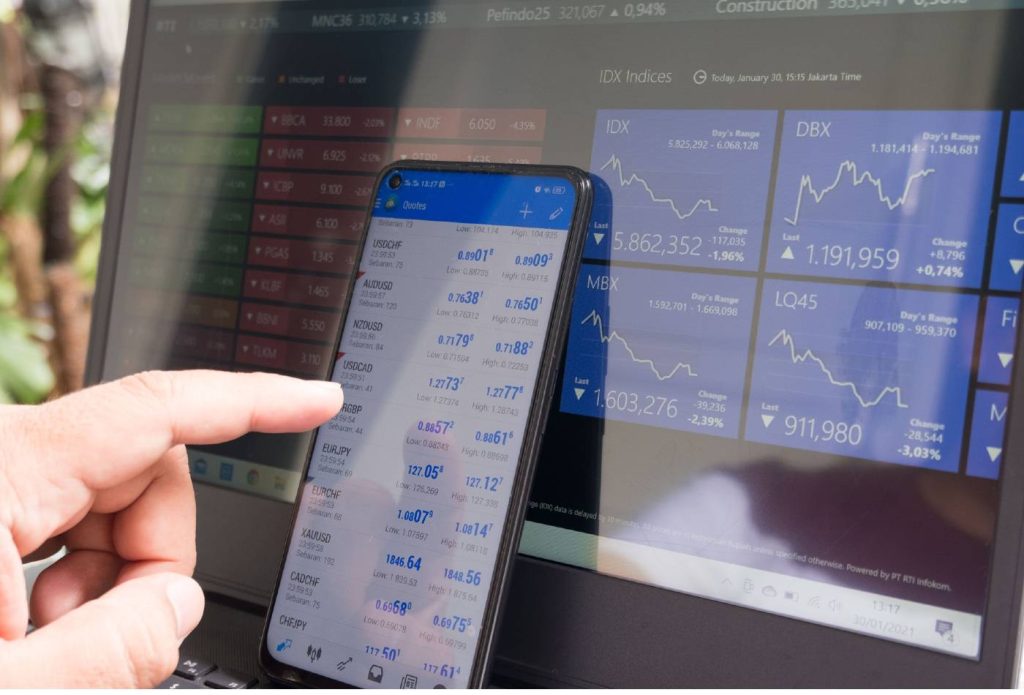This article was last updated on February 1, 2023
Forex technical analysis is a method of evaluating future currency price movements based on past market data, primarily price, and volume. Beginners can start by studying chart patterns, trendlines, and popular indicators such as Moving Averages, Bollinger Bands, and RSI. It is important to understand that technical analysis is not a guarantee of future market behavior, but rather a tool to aid in making informed trading decisions. It should also be used in conjunction with fundamental analysis, which considers economic and political factors that may impact currency prices.
Table of contents
Introduction
Forex technical analysis is a useful tool that traders employ to study and predict how the foreign exchange market will behave. It is a type of data analysis that focuses on the patterns and price movements of currency pairs and gives traders the knowledge they need to make wise choices. The study of price action, which includes looking at charts, trendlines, and other visual representations of price data, is the basis of forex technical analysis. Trades can be made by identifying trends in historical market data and forecasting the course of future price movements.
It is impossible to overestimate the role that technical analysis plays in forex trading. Most effective FX traders’ techniques include technical analysis heavily since it gives them the knowledge they need to make wise decisions and reduce risk. The capacity to swiftly and accurately assess market data is essential to success in the fast-paced world of currency trading.
Forex technical analysis is a complex field that requires a solid understanding of key concepts and terminology. For beginners, it is important to start by learning about chart patterns, trendlines, and popular indicators such as Moving Averages, Bollinger Bands, and RSI. Understanding these concepts is the foundation for successful forex technical analysis, allowing traders to quickly identify trends and make informed decisions about their trades.
Finally, technical analysis for the forex market is a crucial tool for traders who want to be successful in the foreign exchange market. It assists traders in reducing risk and maximizing profits by offering insightful information on the behavior of currency pairs. The knowledge of forex technical analysis is a crucial step toward success in the FX market, regardless of your level of experience.
What is Forex Technical Analysis?
Trading professionals utilize forex technical analysis (FTA) as a useful tool to help them decide what to do in the foreign exchange market. The process entails analyzing a currency pair’s historical pricing data to spot patterns, trends, and other crucial market data. Once future price changes are predicted using this knowledge, a profitable trading strategy may be created.
FTA is based on the assumption that the price of a currency pair already incorporates all important market information, including economic and political factors. This means that traders can gain a better understanding of the market and make more educated predictions about future price movements by monitoring the price changes of a currency pair.
The fact that FTA is founded on data and historical market behavior rather than assumptions or opinions is one of its main advantages. This makes it a trustworthy and impartial method of assessing the market. FTA is primarily focused on the price and volume data of a currency pair, as opposed to fundamental analysis, which also focuses on the economic and political issues that have an impact on the market.
Utilizing different chart patterns, trendlines, and indicators, technical analysis analyzes market data. Moving averages, Bollinger bands, and RSI are a few well-known indicators that give traders information about market trends and probable price changes. It is crucial to realize that in order to obtain a comprehensive picture of the market, technical analysis should be utilized in conjunction with other types of analysis, such as fundamental analysis.
Why is Forex Technical Analysis Important?
An essential component of trading on the foreign exchange market is forex technical analysis. By employing this technique, traders can better comprehend market trends and forecast the course of currency values in the future. By doing so, traders can set suitable stop-loss levels to control their risk and make better judgments about whether to enter or quit transactions.
Technical analysis evaluates past price data using chart patterns, trendlines, and numerous indicators. Traders can spot important levels of support and resistance as well as potential price reversal patterns by looking at historical market data. Once future price changes are predicted using this knowledge, a profitable trading strategy may be created.
The objective character of forex technical analysis is one of its main advantages. Technical analysis is unbiased, unlike other types of analysis like fundamental analysis, which is based on judgments and views. Instead, it bases price changes on data and previous market activity. Because of this, traders can use it as a trustworthy and dependable tool to assess the market.
To acquire a thorough picture of the market, forex technical analysis can also be used in conjunction with other types of analysis, such as fundamental analysis. Traders can make better judgments and reduce their risk by combining the insights from technical and fundamental analysis.
Key Concepts and Terminology
When it comes to forex technical analysis, there are a few key concepts and terminology people should be familiar with in order to effectively use the analysis.
Support and Resistance
Support and resistance are key concepts in forex trading that refer to levels at which prices tend to either stop declining or start rising.
Support refers to a level at which demand for a currency is thought to be strong enough to prevent its price from declining further. In other words, it is a level at which buyers are believed to step in and start buying, preventing the price from falling.
Resistance, on the other hand, refers to a level at which selling pressure is believed to be strong enough to prevent the price from rising further. In other words, it is a level at which sellers are believed to step in and start selling, preventing the price from going up.
Support and resistance levels can be identified by analyzing historical price data and chart patterns. Traders use these levels to make predictions about potential price movements and to make buy or sell decisions. For example, if a currency’s price is approaching a known level of support, traders may enter a long position in anticipation of the price rising. Conversely, if a currency’s price is approaching a known level of resistance, traders may enter a short position in anticipation of the price falling.
It’s important to note that support and resistance levels are not always set in stone and can change over time. Traders should regularly review these levels and adjust their trading strategies accordingly.
Trends
A trend in forex trading refers to the general direction that a currency pair is moving in. Trends can be either upward (bullish), downward (bearish), or sideways (consolidating).
An upward trend, also known as a bullish trend, is characterized by a series of higher highs and higher lows, indicating that the price is generally moving higher.
A downward trend, also known as a bearish trend, is characterized by a series of lower highs and lower lows, indicating that the price is generally moving lower.
A sideways trend, also known as a consolidating trend, is characterized by a lack of clear direction, with the price moving in a narrow range without making significant advances or declines.
Forex traders use trends to make predictions about potential price movements and to inform their buy or sell decisions. For example, if a currency pair is in an upward trend, traders may enter a long position in anticipation of the price continuing to rise. Conversely, if a currency pair is in a downward trend, traders may enter a short position in anticipation of the price continuing to fall.
It’s important to note that trends can change over time and that traders should regularly review the trend of a currency pair and adjust their trading strategies accordingly. Additionally, traders often use technical analysis tools, such as trendlines and moving averages, to help identify trends and make more informed decisions.
Chart Patterns
Chart patterns are visual representations of price movements on a currency pair’s price chart that can be used to make predictions about future price movements. In forex trading, chart patterns are used by traders to identify potential trading opportunities and to inform their buy or sell decisions.
Some common chart patterns include head and shoulders, triangles, wedges, and flag and pennant patterns. Each of these patterns has a distinct appearance and is associated with specific price movements and trends.
Head and shoulders patterns, for example, are reversal patterns that indicate a potential trend change from upward to downward. They are characterized by a peak (left shoulder), a higher peak (head), and a lower peak (right shoulder) that form the shape of a human head and shoulders.
Triangles, on the other hand, are continuation patterns that indicate a potential trend continuation in the direction of the previous trend. They are characterized by a narrowing of the price range, with the price making lower highs and higher lows.
Wedges, flag and pennant patterns, and other chart patterns each have their own unique appearance and associated price movements. By analyzing chart patterns, traders can make predictions about potential price movements and inform their buy or sell decisions.
It’s important to note that chart patterns are not a guarantee of future price movements and that traders should use multiple sources of information, including technical and fundamental analysis, to inform their trading decisions. Additionally, chart patterns can be subjective and may not be easily recognizable in all market conditions.
Indicators
Calculations based on the price and/or volume of a currency pair are used to create forex indicators. These computations are done in order to produce indications that traders can utilize to help them decide whether to purchase or sell.
Leading and trailing indicators are two basic categories into which forex indicators can be divided. Leading indicators are used to provide early signals about possible price moves and are especially helpful in trending markets. Examples of leading indicators include moving averages and the relative strength index (RSI).
Lagging indicators are used to confirm trend direction and give insight into probable trend reversals. Examples include Bollinger Bands and moving average convergence divergence (MACD). They are especially helpful in consolidating markets, where price changes are erratic and trends are challenging to spot.
Moving averages, Bollinger Bands, RSI, MACD, and stochastic oscillator are a few of the most used forex indicators. The calculation and interpretation of each of these indicators varies, and traders frequently combine many indicators to provide a more comprehensive view of the state of the market.
The use of many sources of information, such as technical and fundamental research, to guide trading decisions is advised by traders. Forex indicators are not a guarantee of future price movements. Additionally, forex indicators may not be accurate in all market conditions and may produce false indications.
Conclusion
Forex technical analysis is a critical tool for beginners who are looking to make informed decisions in the foreign exchange market. It provides traders with the ability to analyze historical price data, identify patterns and trends, and make predictions about future price movements. Technical analysis is a data-driven approach that relies on facts and past market behavior rather than opinions or guesswork. This is why it is an essential component of most successful FX traders’ trading strategies.
Forex technical analysis is an incredibly powerful tool that can be used to analyze and identify trends in the foreign exchange market. It is a crucial component of most successful FX traders’ trading strategies and can make the difference between success and failure. This article provided an overview of Forex technical analysis for beginners, covering the basics of what it is and why it is important, as well as key concepts and terminology to be familiar with. We hope this article has been informative and that it has provided valuable insight into forex technical analysis.
Read Next: Start Trading Forex With Only $100





